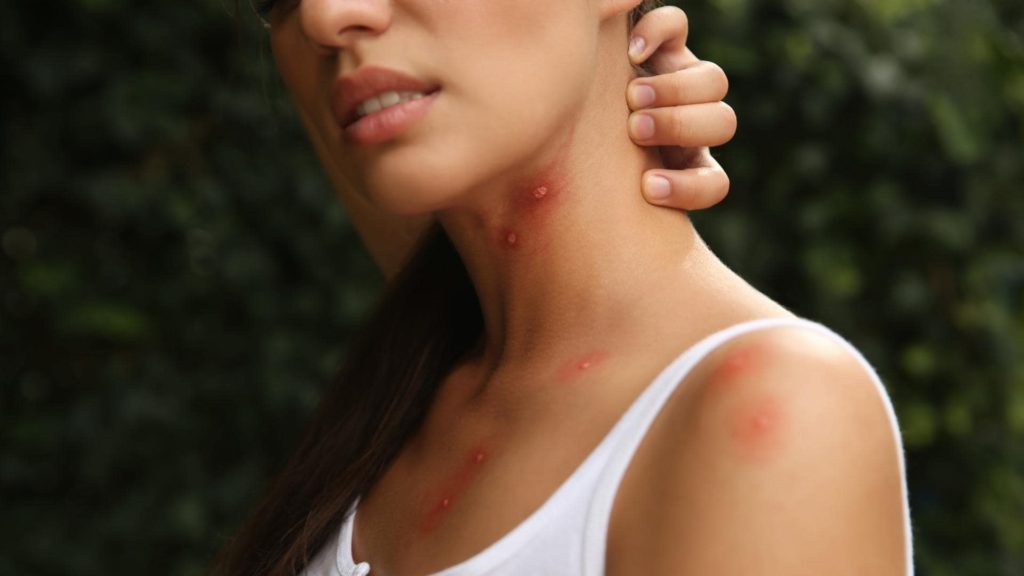The end of summer may be approaching, however Canada’s insects do not seem to be bothered by the weather just yet. For most people, now is a great time to go explore the wilderness this country has to offer. No matter where you choose to go for your next adventure, insects will find a way to adapt and survive in almost any environment and protect their territories, whether it’s in the water, in the mountains, or even in your backyard.
The swarming of insects is aggravating for most people, but insect bites could be a major concern for those with severe allergies. Insects don’t tend to attack someone unless they have been bothered by them directly. In this blog, we’ll discuss first aid for insect bites and stings.
What Type of Insects Should We be Concerned About in Ontario?
Insect and spider bites often cause minor swelling, redness, pain, and itching. These mild reactions are common. They may last from a few hours to a few days. Mild reactions from stinging or biting spiders and insects, such as fleas, flies, and mosquitoes, can usually be treated at home with over-the-counter medications.

Mosquitoes
A mosquito’s bites commonly result in a red, swollen lump on the skin. This can be painful and cause considerable itching. The majority of people infected with the viruses carried by mosquitoes experience either no symptoms or mild ones, such as a fever, headache, muscle pain and fatigue. However, viruses such as malaria, west nile or zika can cause severe life threatening conditions such as paralysis or even coma.

Fleas & Flies
Fleas are tiny, wingless insects with a hard, gleaming surface that jump about. The majority of human flea bites cause only minor discomfort, which may be relieved by household treatment methods such as non-prescription cortisone cream.
The signs and symptoms of flea bites might include the following:
- Zigzag lines on areas such as the feet, legs, and waist.
- Intense itching.
- A single hive or wheal.
- Reddish spots that last even after other symptoms go away in people who aren’t very sensitive to them.
- Blisters or open sores in people who are highly sensitive to flea bites.
Flies are known to make numerous bites in the same regions of the body. The size of the bite does not always indicate what type of fly bit a person. A tiny fly might give rise to a severe, inflamed bite. Swelling, itching, redness, and a tiny but apparent hole in the middle of a bite-like swelling are all signs that a fly has bitten you.
The symptoms of a fly bite can vary depending on the insect. Doctors understand that black fly bites can cause lymph node swelling, for example. Some individuals may have an allergic reaction to a fly’s sting. Symptoms of an allergic reaction include dizziness and weakness. Breathing difficulties or edema (swelling) in various parts of the body might begin to develop.
Bees, Wasps, Hornets
Bee and wasp stings are extremely painful, but they don’t transmit disease. Most people who have severe allergic reactions keep an EpiPen on hand, but for the majority of us, we just have to deal with the initial painful sting and wash out the area as quickly as possible. If your allergic reaction is minimal, you can take an allergy medication such as Benadryl.

Spider Bites
Although spiders can not be categorized as an insect, it is likely to be bitten by one under certain circumstances. While the majority of spider bites are not poisonous and only result in side effects like red skin, swelling, and pain around where the bite occurred, some other spider bites can pose a real risk.
If you experience any adverse reaction to a spider bite, such as difficulty breathing, swallowing, or swelling of the face, seek medical attention immediately. It can be tricky to realize that someone has been bitten by a venomous spider because the signs and symptoms are often indistinguishable from other medical conditions. The only definitive way for a First Aider to know for sure is if they saw the event happen. If you have been bitten by a brown recluse spider, watch for signs and symptoms of a severe reaction. These can include nausea, vomiting, and joint pain within 72 hours of the bite.
Ticks
Ticks can be harmful because they may transmit disease. Black-legged ticks, formerly known as deer ticks, might transmit Lyme disease, and dog ticks can spread Rocky Mountain spotted fever. Lyme disease is an ailment that humans contract from the bite of a deer tick. Contrary to popular belief, people who are infected with Lyme disease may not experience symptoms immediately after they are bitten. It is critical that people with Lyme disease receive a timely diagnosis, since most patients respond well to antibiotics.

Learn how to Provide First Aid for Bites
What are the Symptoms of an Insect Bite or Sting?
Being aware of the symptoms helps you know when you’ve been bitten or stung by an insect. Some individuals do not notice the insect and may not become aware of a bite or sting until one or more of the following symptoms appear:
- Aching, burning, or numbness in the affected area
- swelling
- rash can cause redness
- The affected area or muscles may experience pain.
- itching

The following are some of the most serious symptoms of a severe reaction that necessitates immediate medical treatment:
- fever
- loss of consciousness
- difficulty breathing
- nausea or vomiting
- muscle spasms
- rapid heartbeat
If you’re concerned about an insect bite and have flu-like symptoms the next few days, get examined by a doctor for tests to confirm whether you have an infection or disease that was transferred from the insect.
How to Provide First Aid for Insect Bites and Stings
First aid treatment may vary depending on the type of bite or sting. Typically, less severe bites and stings from mosquitoes, flies, spiders and bees can be treated with allergy medication and an ice pack to reduce swelling. Avoid scratching the area to increase healing speed. After a few days, the bite should reduce, but it is important to keep an eye on it to ensure it does not get worse.
First Aid for Bee Stings
In the cases of a bee sting, though, we suggest to do the following:
- Remove the stinger if it’s still stuck in the person’s skin by scraping it away with a plastic card (such as a debit card).
- Rinse the area with clean water.
- Apply an adhesive bandage to the affected area.
- Use ice or a cold pack to reduce swelling. Put a cloth between the ice and the person’s skin so you don’t accidentally freeze the skin.
- To avoid infection, allergic reactions, or anaphylaxis, keep an eye out for any signs of these conditions.
- Immediately call EMS/911 for medical assistance during severe reactions.
An epinephrine injection (EpiPen) is an adrenaline shot that helps control the severity of a severe allergic reaction, otherwise known as anaphylaxis. The EpiPen injection can be given to most people without medical assistance on the outer thigh, even if they are wearing clothing. Unless there is a first responder, anyone with the required training may assist them in giving adrenaline to assist save a life during an emergency caused by an allergic reaction.

First Aid for Spider Bites
To treat a non-venomous spider bite:
- Rinse the region with water.
- If the person has no documented allergies or sensitivities, apply an antibiotic ointment to the wound.
- To help relieve pain and swelling, apply a cold pack wrapped in a thin, dry towel.
If you’ve been bitten by a black widow or brown recluse spider, take the following steps:
- Call 911 if you believe the person was bit by a black widow or brown recluse spider.
- Thoroughly rinse the area with water.
- Apply a cold pack wrapped in a thin, dry towel to reduce swelling
First Aid for Tick Bites
Brush the tick away if you discover it on the skin; grasp the head of the tick with tweezers or a tick removal key if it has burrowed into the skin. If you are able to remove the tick, be sure to wash the area well with soap and water. If you cannot remove the tick completely, it is best to seek medical attention as soon as possible.
Lyme disease is usually transmitted from the bite of a small deer tick that carries the bacterium. Although not every bite infected with this bacteria causes Lyme disease, it is important to carefully evaluate any bites since early detection and treatment are essential for preventing serious medical complications.

Get Trained as a First Aider
There are only a handful of species of venomous or poisonous insects but it is important to understand how to care for you or a loved one regardless of what bites. Some people have extreme reactions to bug bites or stings, including anaphylactic shock, which can be life-threatening. Don’t let insects ruin whatever is left off summer- learn how to prevent bites and provide the best first aid to deal with them!
Our Standard First Aid training at Coast2Coast covers the training needed to assist in a variety of emergencies, including insect stings and bites. Complete your training in an all-in-class format! With this course, you will learn how to provide aid through hands-on experience. Pick your location and sign up today!



















